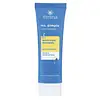What's inside
What's inside
 Key Ingredients
Key Ingredients

 Benefits
Benefits

 Concerns
Concerns

 Ingredients Side-by-side
Ingredients Side-by-side

Water
Skin ConditioningGlycerin
HumectantNiacinamide
SmoothingCaprylic/Capric Triglyceride
MaskingButylene Glycol
HumectantPhenoxyethanol
PreservativePanthenol
Skin ConditioningAcrylates/C10-30 Alkyl Acrylate Crosspolymer
Emulsion StabilisingChlorphenesin
AntimicrobialAmmonium Polyacryloyldimethyl Taurate
Emulsion StabilisingAllantoin
Skin ConditioningSodium PCA
HumectantTriethanolamine
BufferingSodium Hyaluronate
HumectantTetrasodium EDTA
Centella Asiatica Extract
CleansingPolygonum Cuspidatum Root Extract
AntioxidantScutellaria Baicalensis Root Extract
AstringentCamellia Sinensis Leaf Extract
AntimicrobialGlycyrrhiza Glabra Root Extract
BleachingChamomilla Recutita Flower Extract
MaskingRosmarinus Officinalis Leaf Extract
AntimicrobialWater, Glycerin, Niacinamide, Caprylic/Capric Triglyceride, Butylene Glycol, Phenoxyethanol, Panthenol, Acrylates/C10-30 Alkyl Acrylate Crosspolymer, Chlorphenesin, Ammonium Polyacryloyldimethyl Taurate, Allantoin, Sodium PCA, Triethanolamine, Sodium Hyaluronate, Tetrasodium EDTA, Centella Asiatica Extract, Polygonum Cuspidatum Root Extract, Scutellaria Baicalensis Root Extract, Camellia Sinensis Leaf Extract, Glycyrrhiza Glabra Root Extract, Chamomilla Recutita Flower Extract, Rosmarinus Officinalis Leaf Extract
Water
Skin ConditioningEthylhexyl Methoxycinnamate
UV AbsorberPropylene Glycol
Humectant4-Methylbenzylidene Camphor
UV AbsorberAcrylates Copolymer
Dimethicone
EmollientPolyacrylamide
Cyclopentasiloxane
EmollientButylene Glycol
HumectantBenzyl Alcohol
PerfumingPanthenol
Skin ConditioningTriethanolamine
BufferingC13-14 Isoparaffin
EmollientPolysorbate 60
EmulsifyingEthylhexylglycerin
Skin ConditioningParfum
MaskingAloe Barbadensis Leaf Extract
EmollientEpilobium Angustifolium Extract
Skin ConditioningLaureth-7
EmulsifyingBeta-Glucan
Skin ConditioningCarbomer
Emulsion StabilisingTitanium Dioxide
Cosmetic ColorantTocopheryl Acetate
AntioxidantDimethicone Crosspolymer
Emulsion StabilisingDimethicone/Vinyl Dimethicone Crosspolymer
Skin ConditioningPhenoxyethanol
PreservativeDimethiconol
EmollientSodium Metabisulfite
AntioxidantHamamelis Virginiana Extract
AntiseborrhoeicPotassium Sorbate
PreservativeSodium Benzoate
MaskingTocopherol
AntioxidantWater, Ethylhexyl Methoxycinnamate, Propylene Glycol, 4-Methylbenzylidene Camphor, Acrylates Copolymer, Dimethicone, Polyacrylamide, Cyclopentasiloxane, Butylene Glycol, Benzyl Alcohol, Panthenol, Triethanolamine, C13-14 Isoparaffin, Polysorbate 60, Ethylhexylglycerin, Parfum, Aloe Barbadensis Leaf Extract, Epilobium Angustifolium Extract, Laureth-7, Beta-Glucan, Carbomer, Titanium Dioxide, Tocopheryl Acetate, Dimethicone Crosspolymer, Dimethicone/Vinyl Dimethicone Crosspolymer, Phenoxyethanol, Dimethiconol, Sodium Metabisulfite, Hamamelis Virginiana Extract, Potassium Sorbate, Sodium Benzoate, Tocopherol
 Reviews
Reviews

Ingredients Explained
These ingredients are found in both products.
Ingredients higher up in an ingredient list are typically present in a larger amount.
Butylene Glycol (or BG) is used within cosmetic products for a few different reasons:
Overall, Butylene Glycol is a safe and well-rounded ingredient that works well with other ingredients.
Though this ingredient works well with most skin types, some people with sensitive skin may experience a reaction such as allergic rashes, closed comedones, or itchiness.
Learn more about Butylene GlycolPanthenol is a common ingredient that helps hydrate and soothe the skin. It is found naturally in our skin and hair.
There are two forms of panthenol: D and L.
D-panthenol is also known as dexpanthenol. Most cosmetics use dexpanthenol or a mixture of D and L-panthenol.
Panthenol is famous due to its ability to go deeper into the skin's layers. Using this ingredient has numerous pros (and no cons):
Like hyaluronic acid, panthenol is a humectant. Humectants are able to bind and hold large amounts of water to keep skin hydrated.
This ingredient works well for wound healing. It works by increasing tissue in the wound and helps close open wounds.
Once oxidized, panthenol converts to pantothenic acid. Panthothenic acid is found in all living cells.
This ingredient is also referred to as pro-vitamin B5.
Learn more about PanthenolPhenoxyethanol is a preservative that has germicide, antimicrobial, and aromatic properties. Studies show that phenoxyethanol can prevent microbial growth. By itself, it has a scent that is similar to that of a rose.
It's often used in formulations along with Caprylyl Glycol to preserve the shelf life of products.
Triethanolamine is an emulsifier and pH adjuster. It is created using ethylene oxide and ammonia. This gives Triethanolamine a nitrogen core and a similar scent to ammonia.
As an emulsifier, it prevents ingredients from separating and enhances texture by adding volume to a product.
PH adjusters are common in cosmetic products. The pH of a product can affect the effectiveness of other ingredients. A product with a high pH may also irritate the skin.
Learn more about TriethanolamineWater. It's the most common cosmetic ingredient of all. You'll usually see it at the top of ingredient lists, meaning that it makes up the largest part of the product.
So why is it so popular? Water most often acts as a solvent - this means that it helps dissolve other ingredients into the formulation.
You'll also recognize water as that liquid we all need to stay alive. If you see this, drink a glass of water. Stay hydrated!
Learn more about Water